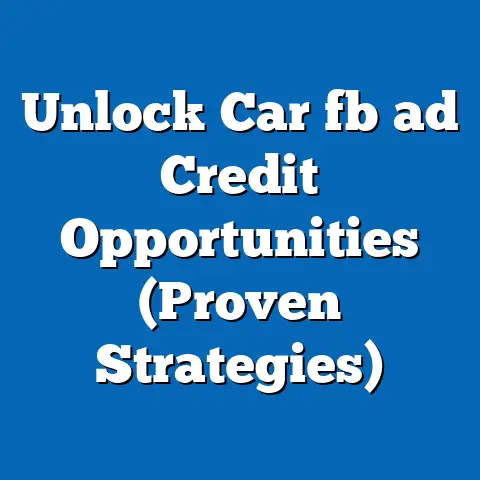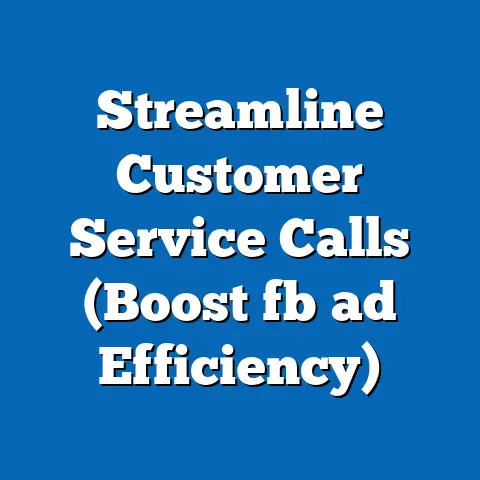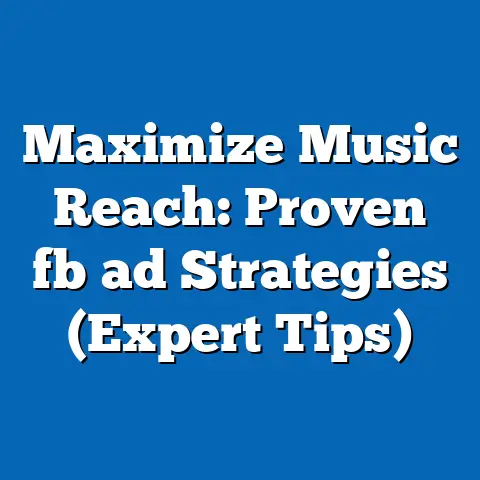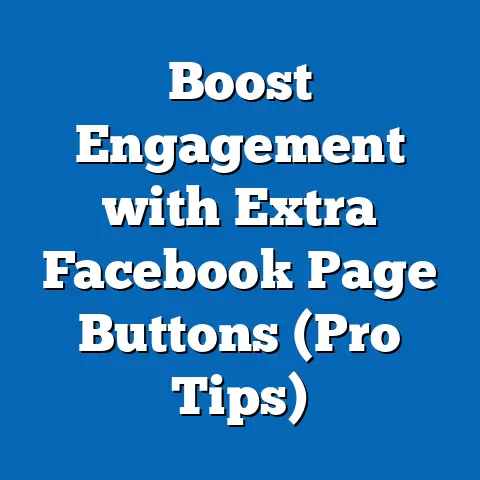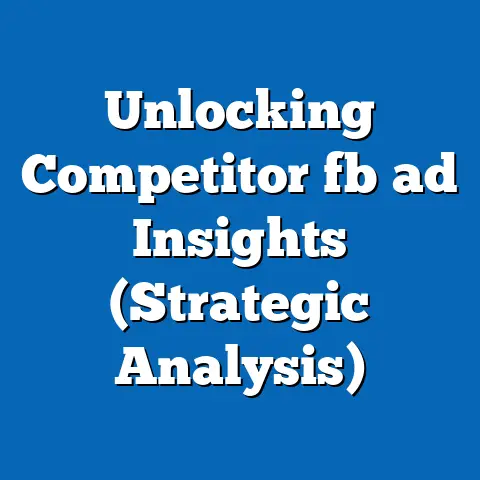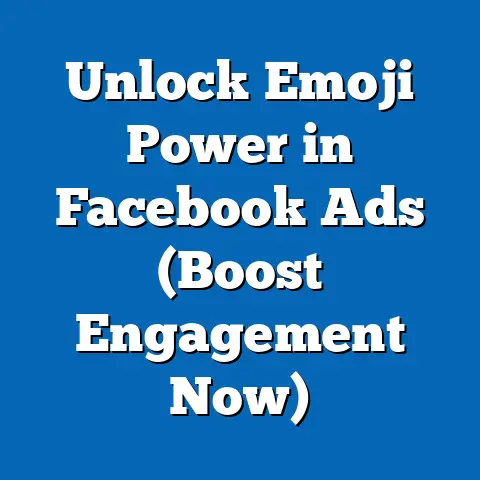Maximize Budget in Facebook Ads (Proven Strategies)
I’ve seen it countless times: a small business owner, bright-eyed and full of hope, plunges into the world of Facebook Ads, only to emerge weeks later, frustrated, with an empty ad budget and little to show for it. They tell me stories of wasted ad spend, disappointing ROI, and the sheer, overwhelming complexity of social media advertising. They feel like they’re throwing money into a black hole, unsure if they’re even reaching the right people.
I remember Sarah, a local bakery owner, who came to me utterly dejected. She’d sunk a significant portion of her marketing budget into Facebook Ads, hoping to attract more customers to her newly opened shop. Instead, she saw minimal foot traffic and her online orders remained stagnant. “I feel like I’m just burning money,” she lamented.
Sarah’s story isn’t unique. But what if I told you that Sarah, and countless others like her, discovered proven strategies that completely transformed their approach to Facebook Ads? Strategies that didn’t just save money, but actually improved campaign performance, increased sales, and fostered a deeper understanding of their target audience?
This article is about that transformation. It’s about taking control of your Facebook Ads budget and making every dollar count. It’s about moving from feeling overwhelmed and frustrated to confident and empowered. It’s about maximizing your impact, even with limited resources. So, buckle up, because I’m about to share the proven strategies that can help you unlock the true potential of Facebook Ads and witness the growth you’ve been dreaming of.
Understanding the Facebook Ads Ecosystem
Before diving into the strategies, it’s crucial to understand the landscape we’re navigating. Facebook Ads isn’t just about creating a pretty picture and hoping for the best. It’s a complex, dynamic system that rewards those who understand its nuances.
Overview of Facebook Ads
At its core, Facebook Ads operates on an auction system. Advertisers bid against each other to display their ads to specific target audiences. The winning bid, combined with the ad’s quality and relevance, determines which ads are shown and to whom. This means that simply having the biggest budget doesn’t guarantee success. You need to be strategic about your bidding, targeting, and creative.
Facebook offers a wide range of ad formats, from single image and video ads to carousel ads, collection ads, and lead generation forms. Each format has its strengths and weaknesses, and the best choice depends on your specific goals and target audience.
Perhaps the most powerful aspect of Facebook Ads is its sophisticated targeting capabilities. You can target users based on demographics, interests, behaviors, and even their connections to your existing customers. This granular targeting allows you to reach the people who are most likely to be interested in your products or services.
Importance of Budgeting
Effective budgeting is the cornerstone of any successful Facebook Ads campaign, especially for businesses with limited resources. Think of your ad budget as fuel for your marketing engine. Too little fuel, and you won’t go far. Too much, and you risk wasting precious resources.
A well-defined budget allows you to:
- Test and Iterate: Without a budget, you can’t afford to experiment with different ad creatives, targeting options, and bidding strategies. Budgeting allows you to test and refine your approach until you find what works best.
- Scale Effectively: Once you’ve identified successful strategies, a budget allows you to scale your campaigns and reach a wider audience.
- Track Performance: A budget provides a benchmark against which to measure your results. By tracking your spending and ROI, you can identify areas for improvement and optimize your campaigns for maximum impact.
- Avoid Overspending: Without a budget, it’s easy to get carried away and overspend on ads that aren’t delivering results. A budget helps you stay disciplined and avoid wasting money.
In essence, budgeting is about making informed decisions about how to allocate your resources to achieve your advertising goals. It’s about maximizing your ROI and ensuring that every dollar you spend is contributing to your bottom line.
Key Metrics to Monitor
To effectively manage your Facebook Ads budget, you need to track the right metrics. These metrics provide insights into your campaign performance and help you identify areas for optimization. Here are some essential metrics to monitor:
- CPA (Cost Per Acquisition): This metric measures the cost of acquiring a new customer or lead through your Facebook Ads campaigns. A lower CPA indicates more efficient spending.
- CTR (Click-Through Rate): This metric measures the percentage of people who see your ad and click on it. A higher CTR indicates that your ad is relevant and engaging to your target audience.
- ROAS (Return on Ad Spend): This metric measures the revenue generated for every dollar spent on Facebook Ads. A higher ROAS indicates a more profitable campaign.
I’ve learned that diligently monitoring these metrics is like having a dashboard for your advertising efforts. It allows you to quickly identify what’s working, what’s not, and make informed decisions to optimize your campaigns for maximum ROI.
Proven Strategies to Maximize Your Facebook Ads Budget
Now, let’s dive into the heart of the matter: the proven strategies that can help you maximize your Facebook Ads budget and achieve your advertising goals.
Strategy 1: Audience Targeting Mastery
I cannot stress this enough: your audience is everything. Targeting the wrong people is like shouting into the void – you’ll waste your money and get nowhere. Facebook’s detailed targeting options are a goldmine, but only if you know how to use them effectively.
- Define Your Ideal Customer: Before you even touch Facebook Ads Manager, take the time to define your ideal customer. What are their demographics (age, gender, location)? What are their interests and hobbies? What are their pain points and aspirations? The more specific you are, the better you can target your ads.
- Leverage Facebook’s Detailed Targeting: Facebook allows you to target users based on a wide range of criteria, including demographics, interests, behaviors, and connections. Experiment with different targeting options to find the sweet spot that resonates with your ideal customer.
- Create Custom Audiences: Custom audiences allow you to target people who have already interacted with your business. You can upload a list of your existing customers, target people who have visited your website, or target people who have engaged with your Facebook page. These audiences are highly valuable because they’re already familiar with your brand.
- Build Lookalike Audiences: Lookalike audiences allow you to reach new people who are similar to your existing customers. Facebook analyzes your custom audiences and identifies common traits and characteristics, then finds other users who share those traits. This is a powerful way to expand your reach and find new customers who are likely to be interested in your products or services.
I remember working with a small e-commerce store that sold handmade jewelry. Initially, they were targeting a broad audience of “women interested in fashion.” Their results were lackluster, and their CPA was through the roof. After digging deeper, we discovered that their ideal customer was actually a woman aged 25-45, interested in sustainable fashion, ethical sourcing, and supporting small businesses. By refining their targeting, we were able to significantly reduce their CPA and increase their sales.
Strategy 2: A/B Testing for Optimization
A/B testing, also known as split testing, is the process of comparing two versions of an ad to see which one performs better. It’s a critical tool for optimizing your Facebook Ads campaigns and maximizing your ROI.
- Test Everything: Don’t assume you know what works best. Test different ad creatives (images and videos), headlines, ad copy, call-to-action buttons, and even audience segments.
- Isolate Variables: When A/B testing, make sure to only change one variable at a time. This allows you to accurately measure the impact of each change. For example, if you’re testing two different headlines, keep everything else the same.
- Use Facebook’s A/B Testing Tool: Facebook Ads Manager has a built-in A/B testing tool that makes it easy to create and manage your tests.
- Analyze Your Results and Iterate: Once your A/B test is complete, analyze the results and identify the winning version. Then, use those insights to inform your future ad campaigns.
I once worked with a client who was struggling to generate leads through their Facebook Ads. We ran an A/B test comparing two different ad creatives: one featuring a professional headshot and the other featuring a customer testimonial. The customer testimonial ad outperformed the headshot ad by a significant margin, resulting in a 50% increase in lead generation.
Strategy 3: Budget Allocation Techniques
How you allocate your budget across different campaigns and ad sets can have a significant impact on your overall results. There are two main budget allocation techniques to consider:
- Campaign Budget Optimization (CBO): With CBO, you set a budget at the campaign level, and Facebook automatically distributes that budget across your ad sets based on performance. This can be a good option if you’re unsure which ad sets will perform best. I’ve found that CBO can be particularly effective for campaigns with multiple ad sets targeting different audience segments.
- Manual Budget Settings: With manual budget settings, you set a budget for each individual ad set. This gives you more control over how your budget is spent, but it also requires more monitoring and optimization. Manual budget settings can be a good option if you have a clear understanding of which ad sets are performing best and you want to allocate more resources to them.
The key is to continuously monitor your campaign performance and reallocate your budget accordingly. If one ad set is consistently outperforming others, consider increasing its budget to capitalize on its success. Conversely, if an ad set is underperforming, consider reducing its budget or pausing it altogether.
Strategy 4: Retargeting Strategies
Retargeting is the process of showing ads to people who have already interacted with your business. This could include people who have visited your website, viewed a product page, added an item to their cart, or engaged with your Facebook page.
- Why Retargeting Works: Retargeting is highly effective because it targets people who are already familiar with your brand and have shown interest in your products or services. They’re further down the sales funnel and are more likely to convert.
- Create Retargeting Audiences: Use Facebook Pixel to track user behavior on your website and create retargeting audiences based on their actions.
- Craft Compelling Retargeting Ads: Your retargeting ads should be tailored to the specific actions that users have taken. For example, if someone added an item to their cart but didn’t complete the purchase, you could show them an ad reminding them of the item and offering a discount.
I’ve seen retargeting campaigns generate incredible results for my clients. One client, a clothing retailer, saw a 300% increase in sales after implementing a retargeting campaign that targeted people who had viewed specific product pages on their website.
Strategy 5: Leveraging Ad Scheduling
Ad scheduling, also known as dayparting, allows you to schedule your ads to run only during specific times of the day or days of the week. This can be a valuable tool for maximizing your budget and reaching your target audience when they’re most active.
- Identify Peak Activity Times: Use Facebook Analytics or Google Analytics to identify the times of day or days of the week when your target audience is most active on Facebook.
- Schedule Your Ads Accordingly: Schedule your ads to run only during those peak activity times. This will help you avoid wasting money on impressions that are unlikely to result in clicks or conversions.
I worked with a restaurant that wanted to promote their lunch specials. We used ad scheduling to target their ads to run only during lunchtime hours (11am-2pm). This allowed them to reach people who were actively looking for lunch options and significantly increased their foot traffic.
Advanced Techniques for Seasoned Advertisers
Once you’ve mastered the fundamentals, you can explore these advanced techniques to further optimize your Facebook Ads campaigns.
Utilizing Facebook Pixel for Enhanced Tracking
The Facebook Pixel is a small piece of code that you install on your website. It tracks user behavior and allows you to measure the effectiveness of your Facebook Ads campaigns.
- Track Conversions: The Pixel allows you to track conversions, such as purchases, leads, and sign-ups, and attribute them to your Facebook Ads campaigns.
- Refine Audience Targeting: The Pixel provides valuable data that you can use to refine your audience targeting. For example, you can create custom audiences based on specific actions that users have taken on your website.
- Improve Ad Relevance: The Pixel helps Facebook understand your target audience and show your ads to the people who are most likely to be interested in them.
I always advise my clients to install the Facebook Pixel as soon as possible. It’s an invaluable tool for tracking performance, optimizing campaigns, and maximizing ROI.
Incorporating Dynamic Ads
Dynamic ads automatically show the most relevant products to potential customers based on their browsing behavior on your website.
- How Dynamic Ads Work: Dynamic ads use your product catalog to create ads that are tailored to the specific products that users have viewed or added to their cart.
- Benefits of Dynamic Ads: Dynamic ads are highly effective because they show users exactly what they’re looking for. They can also help you recover abandoned carts and increase sales.
Dynamic ads are particularly useful for e-commerce businesses with a large product catalog. They can save you time and effort by automating the ad creation process and ensuring that your ads are always relevant to your target audience.
Collaboration with Influencers
Partnering with influencers can be a cost-effective way to reach a wider audience and build brand awareness.
- Find Relevant Influencers: Look for influencers who are relevant to your niche and have a strong following among your target audience.
- Negotiate a Partnership: Negotiate a partnership that aligns with your budget and goals. This could include sponsored posts, product reviews, or affiliate marketing.
- Track Your Results: Track the results of your influencer marketing campaigns to see if they’re generating a positive ROI.
I’ve seen influencer marketing campaigns generate significant results for my clients, particularly in the beauty, fashion, and lifestyle industries.
Conclusion
Maximizing your Facebook Ads budget is not just about spending less; it’s about spending smarter. It’s about understanding your target audience, testing different strategies, and continuously optimizing your campaigns for maximum ROI.
Remember Sarah, the bakery owner I mentioned at the beginning of this article? After implementing the strategies I’ve shared, she saw a dramatic turnaround in her Facebook Ads performance. Her CPA plummeted, her sales increased, and she finally felt like she was getting a return on her investment.
Success on Facebook Ads is achievable, even with a limited budget. It requires dedication, experimentation, and a willingness to learn and adapt. But with the right approach and mindset, you can unlock the true potential of Facebook Ads and witness the transformation in your business growth.
So, take control of your advertising efforts today. Implement these strategies and see the difference they can make. Start small, test often, and never stop learning. The world of Facebook Ads is constantly evolving, but with a strategic and data-driven approach, you can stay ahead of the curve and achieve your advertising goals.
Ready to take your Facebook Ads to the next level? Start by defining your ideal customer and creating your first custom audience. The journey to advertising success starts with a single step!

